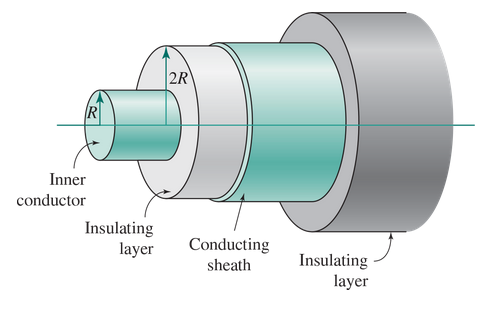A standard coaxial cable consists of a cylindrical central conducting wire, a layer of surrounding insulation, a flexible conducting pipe-like sheath, and a final outer layer of insulation as shown in the figure. Imagine a very long straight stretch of such a wire, and suppose that the inner wire has a charge per unit length of λ and the sheath has a charge per unit lenth of -λ (where λ is a positive constant). a. Argue that the charge must reside in thin layers on the wire's outer surface and the sheath's inner surface. b. Determine Evector (in terms of R, λ, and ε0) in the regions (1) s < R, (2) R < s < 2R, and (3) s > 2R. c. Draw a quantitatively accurate graph of Er as a function of s from s = 0 to s = 3R. The graph will look discontinuous in places. Explain why this does not violate the continuity principle.
A standard coaxial cable consists of a cylindrical central
a. Argue that the charge must reside in thin layers on the wire's outer surface and the sheath's inner surface.
b. Determine Evector (in terms of R, λ, and ε0) in the regions (1) s < R, (2) R < s < 2R, and (3) s > 2R.
c. Draw a quantitatively accurate graph of Er as a function of s from s = 0 to s = 3R. The graph will look discontinuous in places. Explain why this does not violate the continuity principle.

Trending now
This is a popular solution!
Step by step
Solved in 6 steps with 14 images


